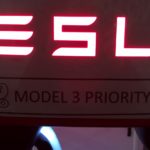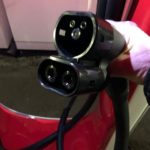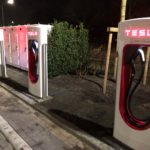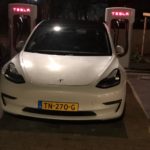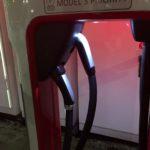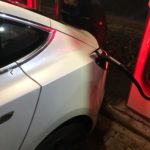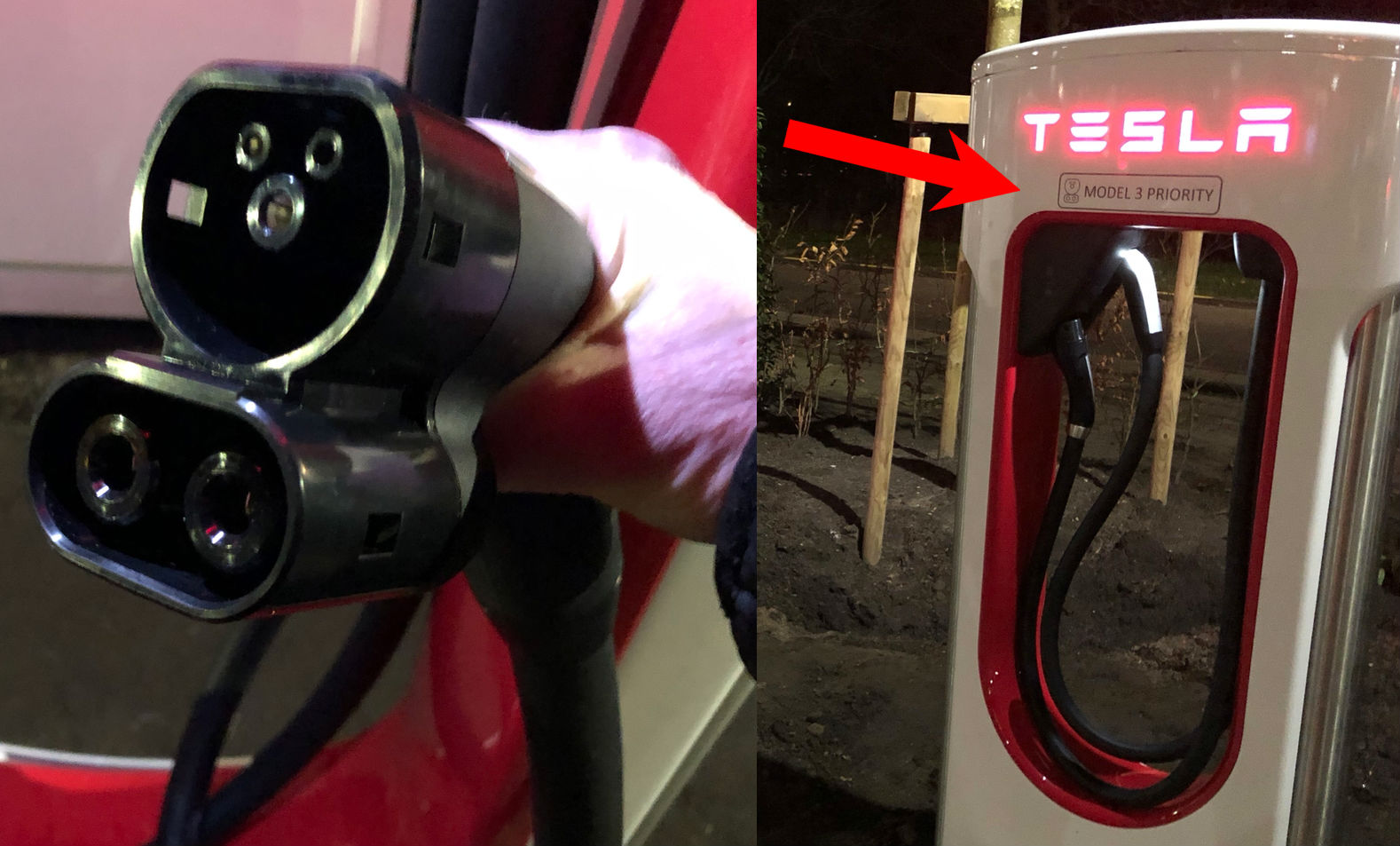
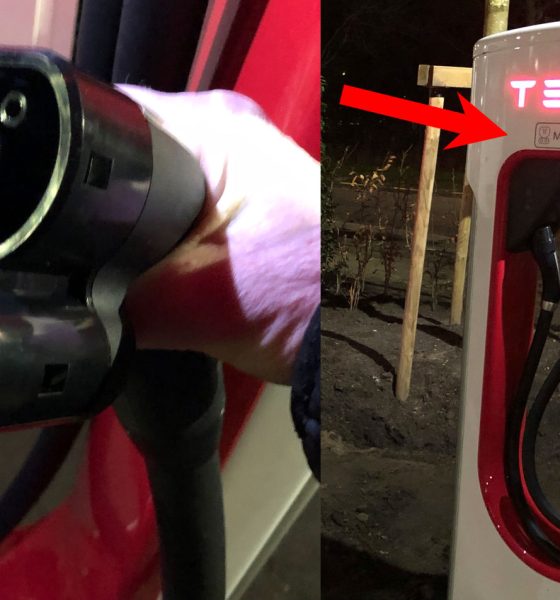
News
Tesla begins Supercharger CCS upgrade ahead of Model 3 rollout in Europe
It is still a couple of months before Model 3 deliveries in Europe are expected to begin, but Tesla is already starting the rollout of dual-charge CCS Superchargers in the region. The company confirmed last month that the Model 3 will be getting a CCS plug for Europe, while a CCS adapter will be introduced for the Model S and X. During its announcement for the Model 3’s charging standard for the region, Tesla noted that it would be “retrofitting our existing Superchargers with dual charge cables to enable Model 3, which will come with a CCS Combo 2 charge port, to use the Tesla Supercharger network.”
Tesla’s adoption of CCS (Combined Charging System) is a notable step for the electric car maker. CCS, after all, is prevalent in the region, being preferred by several European carmakers including BMW, Volkswagen and the Daimler group. The system combines the Type 2 design, which is used for slower AC charging at home or work, as well as with two large DC pins for rapid charging. CCS competes with the CHAdeMO rapid charging standard, which is being used by companies such as Nissan, Mitsubishi and Subaru.
Tesla owner-enthusiast Hans Noordsij visited the site of Tesla’s first dual charge Supercharger station, where he was able to take photos and meet Tesla staff who were working on the updated charging stall. Several details of the upgraded Supercharger were evident from Hans’ images, including a sign indicating that the new stations are “Model 3 Priority.”
- One of Tesla’s first dual-charge, CCS-compatible Superchargers in Europe. (Photo: Hans Noordsij)
- A close-up of Tesla’s CCS plug for the Model 3. (Photo: Hans Noordsij)
- One of Tesla’s first dual-charge, CCS-compatible Superchargers in Europe. (Photo: Hans Noordsij)
One of Tesla’s first dual-charge, CCS-compatible Superchargers in Europe. (Photo: Hans Noordsij)
Speaking to Teslarati after his trip to the Supercharger, Hans noted that Tesla was testing the connection of a Model 3 to the dual charge station when he arrived. Tesla’s staff reportedly informed him that they were aiming to add CCS connectors to every Supercharger in the Netherlands sometime in January.
We reached out to Tesla for more information about its first dual charge CCS Supercharger in Europe. The electric car maker noted that the first upgraded stations are located at the Badhoevedorp Supercharger near the Corendon Village Hotel, just outside Amsterdam. The site currently has 20 Superchargers, and Tesla is installing 8 more stalls on the site, each of which is fitted with both a CCS and a Type 2 connector. When completed, 8 out of the 28 stalls in the location would be compatible with the Model 3, S, and X, while the remaining 20 would be compatible with the flagship sedan and SUV.
Tesla plans to fully retrofit Europe’s Supercharger Network with its dual charge CCS system, allowing the Model 3 to have access to Tesla’s expansive charging infrastructure. While Tesla is in the process of retrofitting its Superchargers with CCS plugs, though, Model 3 owners in the region could expect their vehicles to smartly suggest charging stations that are fitted with the necessary connectors. The location, as well as the availability of these CCS stalls, would be displayed on the Model 3’s display.
- A Tesla Model 3 gets connected to one of Tesla’s first dual-charge, CCS-compatible Superchargers in Europe. (Photo: Hans Noordsij)
- One of Tesla’s first dual-charge, CCS-compatible Superchargers in Europe. (Photo: Hans Noordsij)
- A Tesla Model 3 gets connected to one of Tesla’s first dual-charge, CCS-compatible Superchargers in Europe. (Photo: Hans Noordsij)
A Tesla Model 3 gets connected to one of Tesla’s first dual-charge, CCS-compatible Superchargers in Europe. (Photo: Hans Noordsij)
Europe is a pivotal part of Tesla’s strategy for the Model 3, considering that the premium sedan segment is twice as big in the region as it is in the United States. The Model 3 is already performing well in the US, despite the country being enamored by SUVs and pickup trucks. In a market where sedans are prevalent such Europe, the Model 3’s potential is vast.
Considering that Tesla is now rolling out CCS plugs on its European Supercharger Network, the idea of Tesla sharing its charging infrastructure with other electric cars emerges once more. Tesla’s head of global charging infrastructure, Drew Bennett, addressed this in an interview with Auto Express UK, where he noted that several EV makers have already reached out to Tesla about sharing the Supercharger Network.
“We’re definitely open to talking to other car manufacturers who want to have access to the network. Capacity is a driver for our investment; it’s new routes, new markets and then capacity. A lot of car makers have spoken to us about it, but we haven’t had any conclusive discussions on it. They’re still trying to figure out what they would need in a network, but we’re a couple of years ahead of them in terms of embracing the investment required to transition to EVs,” Bennett said.

Elon Musk
Tesla CEO Elon Musk teases insane capabilities of next major FSD update
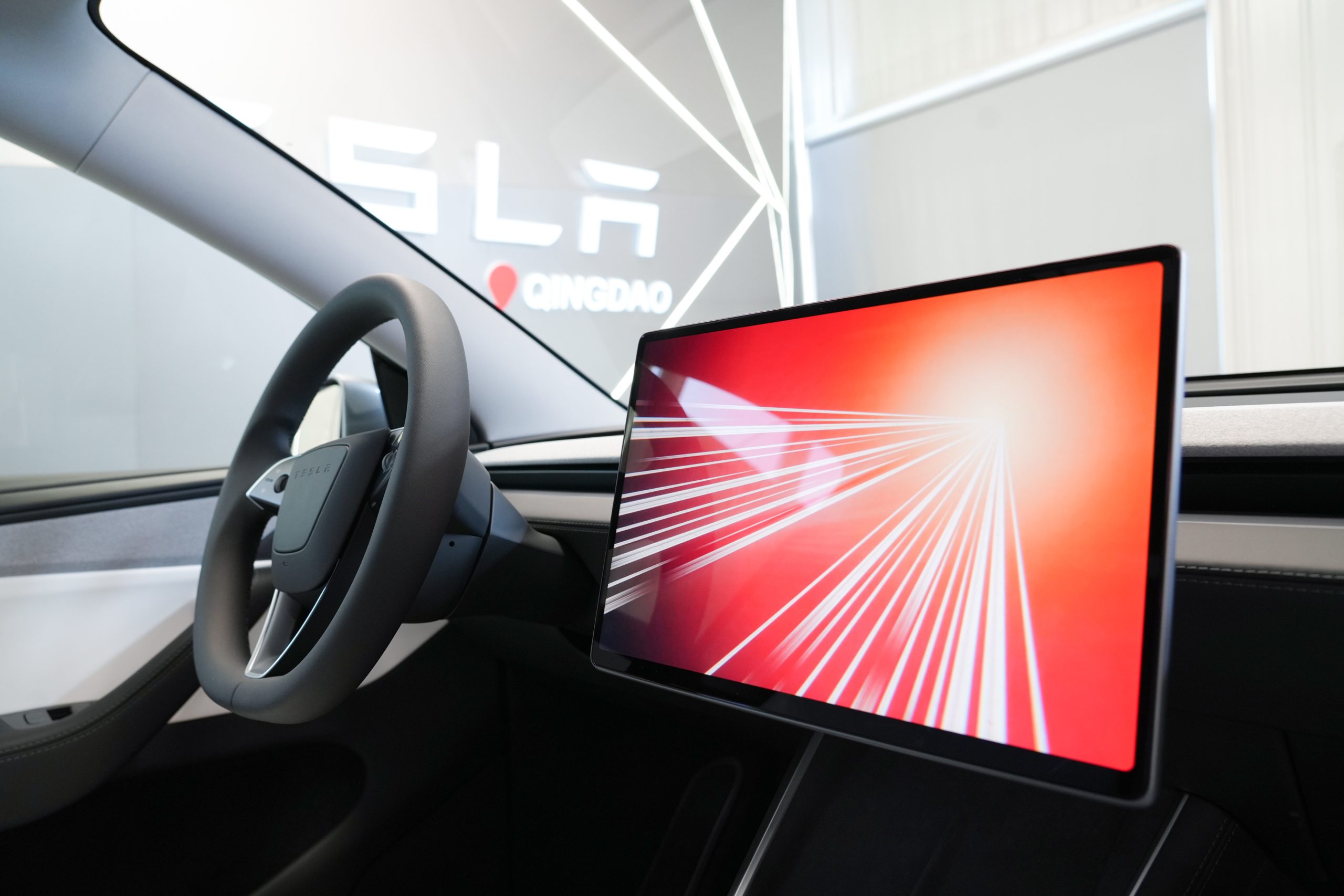
Tesla CEO Elon Musk teased the insane capabilities of the next major Full Self-Driving update just hours after the company rolled out version 14.2 to owners.
Tesla Full Self-Driving v14.2 had some major improvements from the previous iteration of v14.1.x. We were on v14.1.7, the most advanced configuration of the v14.1 family, before Tesla transitioned us and others to v14.2.
However, Musk has said that the improvements coming in the next major update, which will be v14.3, will be where “the last big piece of the puzzle finally lands.”
14.3 is where the last big piece of the puzzle finally lands
— Elon Musk (@elonmusk) November 21, 2025
There were some major improvements with v14.2, most notably, Tesla seemed to narrow in on the triggers that caused issues with hesitation and brake stabbing in v14.1.x.
One of the most discussed issues with the past rollout was that of brake stabbing, where the vehicle would contemplate proceeding with a route as traffic was coming from other directions.
We experienced it most frequently at intersections, especially four-way stop signs.
Elon Musk hints at when Tesla can fix this FSD complaint with v14
In our review of it yesterday, it was evident that this issue had been resolved, at least to the extent that we had no issues with it in a 62-minute drive, which you can watch here.
Some owners also reported a more relaxed driver monitoring system, which is something Tesla said it was working on as it hopes to allow drivers to text during operation in the coming months. We did not test this, as laws in Pennsylvania prohibit the use of phones at any time due to the new Paul Miller’s Law, which took effect earlier this year.
However, the improvements indicate that Tesla is certainly headed toward a much more sentient FSD experience, so much so that Musk’s language seems to be more indicative of a more relaxed experience in terms of overall supervision from the driver, especially with v14.3.
Musk did not release or discuss a definitive timeline for the release of v14.3, especially as v14.2 just rolled out to Early Access Program (EAP) members yesterday. However, v14.1 rolled out to Tesla owners just a few weeks ago in late 2025. There is the potential that v14.3 could be part of the coming Holiday Update, or potentially in a release of its own before the New Year.
News
Tesla Full Self-Driving v14.2 – Full Review, the Good and the Bad

Tesla rolled out Full Self-Driving version 14.2 yesterday to members of the Early Access Program (EAP). Expectations were high, and Tesla surely delivered.
With the rollout of Tesla FSD v14.2, there were major benchmarks for improvement from the v14.1 suite, which spanned across seven improvements. Our final experience with v14.1 was with v14.1.7, and to be honest, things were good, but it felt like there were a handful of regressions from previous iterations.
While there were improvements in brake stabbing and hesitation, we did experience a few small interventions related to navigation and just overall performance. It was nothing major; there were no critical takeovers that required any major publicity, as they were more or less subjective things that I was not particularly comfortable with. Other drivers might have been more relaxed.
With v14.2 hitting our cars yesterday, there were a handful of things we truly noticed in terms of improvement, most notably the lack of brake stabbing and hesitation, a major complaint with v14.1.x.
However, in a 62-minute drive that was fully recorded, there were a lot of positives, and only one true complaint, which was something we haven’t had issues with in the past.
The Good
Lack of Brake Stabbing and Hesitation
Perhaps the most notable and publicized issue with v14.1.x was the presence of brake stabbing and hesitation. Arriving at intersections was particularly nerve-racking on the previous version simply because of this. At four-way stops, the car would not be assertive enough to take its turn, especially when other vehicles at the same intersection would inch forward or start to move.
This was a major problem.
However, there were no instances of this yesterday on our lengthy drive. It was much more assertive when arriving at these types of scenarios, but was also more patient when FSD knew it was not the car’s turn to proceed.
Can report on v14.2 today there were ZERO instances of break stabbing or hesitation at intersections today
It was a significant improvement from v14.1.x
— TESLARATI (@Teslarati) November 21, 2025
This improvement was the most noticeable throughout the drive, along with fixes in overall smoothness.
Speed Profiles Seem to Be More Reasonable
There were a handful of FSD v14 users who felt as if the loss of a Max Speed setting was a negative. However, these complaints will, in our opinion, begin to subside, especially as things have seemed to be refined quite nicely with v14.2.
Freeway driving is where this is especially noticeable. If it’s traveling too slow, just switch to a faster profile. If it’s too fast, switch to a slower profile. However, the speeds seem to be much more defined with each Speed Profile, which is something that I really find to be a huge advantage. Previously, you could tell the difference in speeds, but not in driving styles. At times, Standard felt a lot like Hurry. Now, you can clearly tell the difference between the two.
It seems as if Tesla made a goal that drivers should be able to tell which Speed Profile is active if it was not shown on the screen. With v14.1.x, this was not necessarily something that could be done. With v14.2, if someone tested me on which Speed Profile was being used, I’m fairly certain I could pick each one.
Better Overall Operation
I felt, at times, especially with v14.1.7, there were some jerky movements. Nothing that was super alarming, but there were times when things just felt a little more finicky than others.
v14.2 feels much smoother overall, with really great decision-making, lane changes that feel second nature, and a great speed of travel. It was a very comfortable ride.
The Bad
Parking
It feels as if there was a slight regression in parking quality, as both times v14.2 pulled into parking spots, I would have felt compelled to adjust manually if I were staying at my destinations. For the sake of testing, at my first destination, I arrived, allowed the car to park, and then left. At the tail-end of testing, I walked inside the store that FSD v14.2 drove me to, so I had to adjust the parking manually.
This was pretty disappointing. Apart from parking at Superchargers, which is always flawless, parking performance is something that needs some attention. The release notes for v14.2. state that parking spot selection and parking quality will improve with future versions.
Any issues with parking on your end? 14.1.7 didn’t have this trouble with parking pic.twitter.com/JPLRO2obUj
— TESLARATI (@Teslarati) November 21, 2025
However, this was truly my only complaint about v14.2.
You can check out our full 62-minute ride-along below:
Elon Musk
SpaceX issues statement on Starship V3 Booster 18 anomaly
The incident unfolded during gas-system pressure testing at the company’s Massey facility in Starbase, Texas.

SpaceX has issued an initial statement about Starship Booster 18’s anomaly early Friday. The incident unfolded during gas-system pressure testing at the company’s Massey facility in Starbase, Texas.
SpaceX’s initial comment
As per SpaceX in a post on its official account on social media platform X, Booster 18 was undergoing gas system pressure tests when the anomaly happened. Despite the nature of the incident, the company emphasized that no propellant was loaded, no engines were installed, and personnel were kept at a safe distance from the booster, resulting in zero injuries.
“Booster 18 suffered an anomaly during gas system pressure testing that we were conducting in advance of structural proof testing. No propellant was on the vehicle, and engines were not yet installed. The teams need time to investigate before we are confident of the cause. No one was injured as we maintain a safe distance for personnel during this type of testing. The site remains clear and we are working plans to safely reenter the site,” SpaceX wrote in its post on X.
Incident and aftermath
Livestream footage from LabPadre showed Booster 18’s lower half crumpling around the liquid oxygen tank area at approximately 4:04 a.m. CT. Subsequent images posted by on-site observers revealed extensive deformation across the booster’s lower structure. Needless to say, spaceflight observers have noted that Booster 18 would likely be a complete loss due to its anomaly.
Booster 18 had rolled out only a day earlier and was one of the first vehicles in the Starship V3 program. The V3 series incorporates structural reinforcements and reliability upgrades intended to prepare Starship for rapid-reuse testing and eventual tower-catch operations. Elon Musk has been optimistic about Starship V3, previously noting on X that the spacecraft might be able to complete initial missions to Mars.
